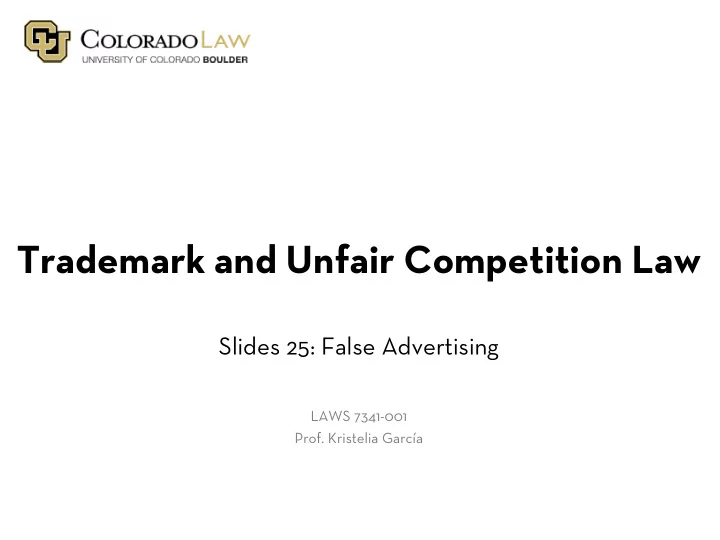

Trademark and Unfair Competition Law Slides 25: False Advertising LAWS 7341-001 Prof. Kristelia García
Class Outline • False Advertising • Literal falsity • Misleading • Materiality 2
False Advertising Lanham Act § 43(a) forbids false designation of origin or false or misleading factual description or representation… 3
Trademark Infringement (43(a)(1)(A)) v. False Advertising (43(a)(1)(B)) • § 43(a) forbids false designation of origin or false or misleading factual description or representation: – Subpart (1)(A) applies if that falsehood deceives as to “affiliation, connection or association of such person with another person, or as to the origin of . . . goods” – A TRADEMARK INFRINGEMENT CLAIM – Subpart (1)(B) applies if that falsehood is in advertising and it misrepresents the nature, characteristics, qualities or geographic origin of . . . goods – A FALSE ADVERTISING CLAIM 4
Lanham Act Section 43(a)(1)(B) • § 43(a)(1) Any person who, on or in connection with any goods or services, or any container for goods, uses in commerce any word, term, name, symbol, or device, or any combination thereof, or any false designation of origin, false or misleading description of fact, or false or misleading representation of fact, which-– – (B) in commercial advertising or promotion, misrepresents the nature, characteristics, qualities, or geographic origin of his or her or another person’s goods, services, or commercial activities, shall be liable in a civil action by any person who believe that he or she is or is likely to be damaged by such act. 5
Statements that may trigger 43(a)(1)(B): • A literally false statement ( Clorox ) • A literally false by necessary implication statement ( Time Warner ) • A merely misleading (i.e., impliedly false) statement ( Papa John’s ) 6
To make a prima facie case of false advertising, P must establish: 1. A false or misleading statement of fact about a product; 2. Such statement either deceived, or had the capacity to deceive a substantial segment of potential consumers; 3. The deception is material, in that it is likely to influence the consumer’s purchasing decision; 4. The product is in interstate commerce; and 5. The plaintiff has been or is likely to be injured as a result of the statement at issue. 7
Elements of a § 43(a)(1)(B) False Advertising Claim 1. Falsity: Advertisement makes a false statement 2. Believability: Falsehood deceives a substantial segment of the audience 3. Materiality: The falsehood is material to the purchasing decision 4. Commerce: Interstate Commerce 5. Injury: Likely injury to the plaintiff 8
9
10
Determining “literal” falsity • Requires determination of the claim conveyed by the advertisement – Consider explicit claims in the advertisement v. claims that the advertisement conveys by “necessary implication”: • “A claim is conveyed by necessary implication when, considering the advertisement in its entirety, the audience would recognize the claim as readily as if it had been explicitly stated” – Focus on “overall theme” of the advertisement 11
12
13
14
Recommend
More recommend